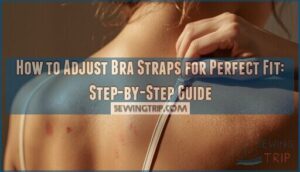This site is supported by our readers. We may earn a commission, at no cost to you, if you purchase through links.
Your shoulders ache by mid-afternoon, and red grooves mark your skin every time you unhook your bra. This daily discomfort isn’t something you have to live with—it’s often a simple matter of adjusting bra straps for fit.
Each strap carries an average of 2.4 kilograms, and when that weight sits in the wrong place, your body pays the price through nerve compression, postural strain, and constant fidgeting.
The fix doesn’t require buying expensive new lingerie or accepting discomfort as normal. Proper strap adjustment transforms how your bra bolsters you, redistributing pressure away from your shoulders and letting the band do its job. Small changes to strap length make the difference between ending your day exhausted and moving through it comfortably.
Table Of Contents
Key Takeaways
- Your bra band does 80% of the support work, so get your band and cup size right before adjusting straps—no amount of strap tweaking fixes a loose band or small cup.
- Proper strap adjustment redistributes the 2.4 kg weight on each shoulder, reducing nerve compression and shoulder grooves while improving your posture throughout the day.
- Bra straps lose elasticity within 6–12 months of regular wear, making hand washing and air drying essential to extend lifespan, and replacement necessary when adjustments no longer hold.
- Individual strap adjustment accounts for natural breast asymmetry—more than half of women have uneven breasts, so each strap needs its own tension to reduce shoulder discomfort and strap slippage by up to 23%.
Why Bra Strap Adjustment Matters
You might think bra straps are just there to keep things in place, but they’re actually doing a lot more work than that. When your straps sit right, they team up with your band to lift your chest and take pressure off your back and shoulders.
Getting this balance right isn’t just about comfort—it affects how you stand, how you feel, and whether you end up with those telltale shoulder grooves at the end of the day.
Role of Bra Straps in Support
Your bra straps carry less weight than you might think. While the band does over 80% of the support work, your straps still handle a significant load—about 2.4 kg per shoulder on average.
Your bra band does over 80% of the support work, while straps handle about 2.4 kg per shoulder
Proper strap orientation and width matter because they affect how that pressure distributes across your shoulder. According to studies, different strap designs can impact bra strap discomfort.
When adjusted correctly, straps reduce breast displacement and improve overall comfort perception.
Impact on Comfort and Posture
When adjusting bra straps goes wrong, you’ll feel it. Overly tight straps create shoulder grooves and nerve compression that can cause numbness down your arms. Poor bra fit contributes to postural strain, forward-rolled shoulders, and increased spinal curvature in your upper back.
Women with larger breasts face higher risks of neck pain and breathing difficulties.
Proper bra adjustment helps your body maintain natural alignment and reduces daily discomfort. Ill-fitting bras may even contribute to bra strap syndrome.
Signs Your Straps Need Adjusting
Your body sends clear signals when something’s off. If you’re constantly readjusting throughout the day—more than 59% of women do this at least once daily—your straps aren’t right.
Watch for red shoulder indentations that last beyond 15 minutes, straps that keep slipping off, or one strap digging while the other slides down. When your band rides up, strap issues usually follow.
Preparing to Adjust Bra Straps
Before you start adjusting your bra straps, you need to make sure the foundation is solid. A few quick checks can save you time and help you avoid adjusting the wrong thing.
Let’s walk through three essential steps that set you up for a proper strap adjustment.
Checking Band and Cup Fit First
Your straps aren’t the problem if your band or cup fit is off. Before you touch those adjusters, check your bra size first. About 80% of women wear the wrong size, and no amount of strap tweaking can fix a loose band or small cup.
The band provides 80–90% of support—straps just help. Get the foundation right, then adjust upward.
Locating The Slide Adjuster
Once you’ve confirmed your band and cup fit, finding the slide adjuster is your next move. This small mechanism controls strap length and sits on each shoulder strap.
What you’ll find:
- Metal or plastic slider – usually rectangular or circular, about 0.8–1.2 cm wide
- Back placement – around 88% of bras position adjusters near your shoulder blade
- Looped strap – the fabric threads through creating adjustable length
Assessing Strap Elasticity
Before you adjust bra straps, test their elasticity by sliding a finger underneath and pulling up gently. Healthy elastic snaps back instantly, while worn-out straps stay stretched.
Premium elastic recovery rates reach 95% after repeated use, but washing impacts and daily strain cause degradation indicators like rippling or curling.
If your straps feel limp or need constant tightening, replacement timing has arrived—elasticity can’t be restored.
Step-by-Step Bra Strap Adjustment
Once you’ve confirmed your band and cup fit correctly, you’re ready to fine-tune your straps.
The process is straightforward, but getting each strap just right makes all the difference in how your bra feels throughout the day. Here’s how to tighten, loosen, and adjust each strap for balanced support.
How to Tighten Bra Straps
Most women need to readjust straps every few months to maintain proper support. Start by locating the slider—the small clip on your strap. Hold it steady and pull the front portion toward the cup to tighten bra straps.
Check for symmetry importance by ensuring both sides match evenly. Test your adjustment with movement testing: raise your arms and rotate your shoulders to confirm the band tightness stays secure without restricting motion.
How to Loosen Bra Straps
When your shoulders show red grooves or feel sore, it’s time to reduce shoulder pressure. Hold the slide adjuster and pull the back portion down toward the band to loosen bra straps.
This simple bra strap adjustment technique helps prevent skin irritation and correct posture changes. Daily readjustment improves physical performance and comfort throughout your day.
Adjusting Each Strap Individually
Your breasts aren’t identical, so each strap needs its own individual fit. More than half of women show breast asymmetry, making independent tension essential for comfort. Adjust one strap at a time until both cups sit flush and level.
This asymmetry adjustment reduces shoulder discomfort and cuts strap slippage by up to 23%. Don’t worry if adjusting bra straps to different lengths looks uneven—it’s normal and necessary for proper support.
Troubleshooting Common Strap Problems
Even with careful adjustment, you might still run into strap issues that don’t seem to go away. Some problems point to a fit issue, while others mean your bra has reached the end of its useful life.
Let’s walk through the most common strap challenges and what you can do to fix them.
Straps Digging Into Shoulders
If you notice red marks or shoulder pain after wearing your bra, your straps are likely bearing too much weight. Digging straps often signal that your band isn’t providing the 80% of support it should.
Loosening the straps slightly can offer strap pressure relief, but if marks persist, you may need a smaller band size or wider strap benefits to distribute weight better and protect your posture.
Straps Slipping Off Shoulders
When straps slip off repeatedly, shoulder slope and strap design are usually to blame. Tighten the adjusters first, but if slipping straps persist even at the shortest setting, your band size may be too loose or your cup size too small.
Try racerback styles or bras with center-pull straps that sit closer to your neck. Material fatigue in older bras also reduces tension, making adjusting bra straps ineffective.
Straps Losing Elasticity
Over time, even high-quality bra straps lose their spring. Most bras maintain good elasticity for about 6–12 months of regular wear before the elastic fibers start to fatigue. When strap adjustments don’t hold anymore, it’s not your technique—it’s material breakdown.
Common signs your bra strap elasticity is fading:
- Straps slip loose throughout the day even after tightening
- Visible fraying or stiff, brittle texture along the strap
- You’re adjusting to the tightest setting but still lack support
- The band rides up while straps dig in
Heat from dryers, body oils, and frequent stretching all speed up degradation. Hand washing in cool water and rotating at least three bras can extend lifespan, but once elasticity is gone, replacement is the only real fix.
When Strap Adjustment Isn’t Enough
Sometimes you can fiddle with straps all day and still feel uncomfortable. That usually means the real problem lies elsewhere. Band fit issues—like a band that rides up or stretches beyond two inches from your back—signal you need a smaller band, not tighter straps.
Cup size mismatch causes spillage or gaping that strap tweaks can’t fix.
Structural strap problems, like digging despite loosening, mean it’s time to replace the bra or try wider straps and different style/placement options.
Fine-Tuning for Comfort and Support
Getting your straps adjusted right is just the start. A few small tweaks after you wear and wash your bra can make a big difference in how it feels throughout the day.
Let’s look at two simple ways to keep your straps working their best.
Re-adjusting After Washing
Washing affects bra straps more than you might realize—studies show elasticity drops by up to 20% after 25 cycles, making strap adjustments essential after every laundry day. Here’s how to maintain proper support:
- Check your slide adjuster immediately after washing, as about 78% of users need to readjust for restored fit
- Hand wash when possible to reduce stretching by 23% compared to machine washing
- Air dry instead of using heat, which causes 12% more elasticity loss
- Test strap tension by sliding a finger underneath—it should feel snug but not tight
Support trends decline without regular post-wash care, but adjusting bra straps right after laundering restores comfort in 89% of cases and extends material longevity.
Using Strap Cushions or Accessories
If your straps dig in or slip despite adjusting bra straps correctly, strap cushions can help. Gel pads and silicone accessories spread pressure across a wider shoulder area, reducing discomfort by 20–40% in some users. They work best with crossed-back styles to prevent slipping straps.
While cushion effectiveness varies, 79% of users report better comfort ratings. Look for designs 2.5–4.5 cm wide with secure attachments.
Choosing Bras for Better Strap Fit
Sometimes adjusting your straps only goes so far. The right bra design can make all the difference in how your straps fit and feel throughout the day.
Let’s look at key features when shopping for bras that work with your body.
Strap Styles and Placement
Not all shoulder straps sit the same way on your body. Traditional over-the-shoulder straps work for most people, but cross-back and racerback styles reduce slipping by 31% if you have narrow shoulders. Halter support loops around your neck for formal wear, while wide-set placements suit balconette cups.
Strap position matters as much as adjusting bra straps—center-pull designs distribute weight more evenly than side-pull options.
Wider Vs. Narrow Straps
When you’re finetuning bra straps, width changes everything. Wider straps slash shoulder pressure by distributing weight over more surface—studies show they reduce peak force considerably compared to narrow designs. You’ll notice better support stability and less digging, especially with larger cup sizes.
Narrow straps work under certain tops but lose elasticity faster. Most women prefer wide, adjustable straps for comfort preferences and long-term garment compatibility.
When to Replace Your Bra for Fit
Even a perfect bra adjustment can’t rescue a worn-out bra. After six months of regular wear, strap elasticity loss and support degradation compromise fit no matter how you adjust. Here’s when adjusting bra straps won’t solve your problems:
- Straps stretch to the tightest setting but still slip
- Fabric shows tears, fading, or loose seams
- Cups gape or overflow despite fit alterations
- Underwires poke through or shift position
- Persistent discomfort even after careful adjustment
Replacement frequency matters for your comfort and health.
Frequently Asked Questions (FAQs)
How do you make bra straps fit?
To make bra straps fit, you’ll use the slide adjuster on each strap. Tighten by pulling the adjuster toward the cup, or loosen by pushing it toward the band, achieving balanced strap tightness for proper support.
How to adjust bra straps correctly?
Think of bra strap adjustment like fine-tuning an instrument. Locate your slide adjuster, pull the front section to tighten or the back to loosen.
Adjust each strap individually—your breasts aren’t identical.
Retighten after washing since elasticity shifts with wear and use.
How do you know if your bra straps are too loose?
Strap slippage off your shoulders during daily movement is the clearest sign. Watch for shoulder gaps when you raise your arms, cup gaping near the straps, or if two fingers slide under with excess space.
Your band should stay level while straps slip—that’s pure looseness, not size issues.
What to do if your bra straps are too long?
Your straps could be miles too long if they constantly slip off. Start by checking your band and cup size—a loose band often masks strap problems.
Then tighten using the slide adjuster. If slipping persists, consider racerback styles or professional alterations for better strap placement and elasticity troubleshooting.
How do bra materials affect strap fit?
Material choices dramatically impact how your bra straps perform. Nylon-spandex blends maintain elasticity retention far better than cotton alone, while wider straps distribute support performance more effectively.
Microfiber reduces skin sensitivity issues by 33%, and high-elastane fabrics improve adjustability precision for an individual fit that lasts.
Can strap adjusters wear out over time?
Yes, strap adjusters wear out over time. Metal adjusters last longer than plastic ones, which are more prone to cracking under stress. Frequent washing, heat, and repeated adjustments accelerate material fatigue.
Signs of wear include loosening straps or visible damage near sliders—time to replace your bra.
Do different sports bras require specific adjustments?
Different sports bras absolutely need specific adjustments based on impact level and design variations. High-impact styles feature wide, adjustable straps for stability, while racerback designs often lack adjustability.
Convertible straps offer flexibility for larger bust sizes and varying activity types, making strap adjustability essential for proper support.
How to prevent strap irritation on sensitive skin?
Sensitive skin needs straps that don’t dig in. Choose wider, cushioned straps to reduce friction and pressure. Pick bras with plastic hardware instead of nickel.
Keep the strap area dry to prevent moisture-related irritation. Consider anti-chafing balms for extra protection during activity.
Are there techniques for enhancing strap durability?
Absolutely. High-density elastane blends and silicone gel inlays extend strap life considerably. Reinforced stitching at attachment points prevents failure. Replace worn slide adjusters to restore function and extend usable lifespan.
Hand wash gently, air dry, and rotate between multiple bras—this threefold increases durability.
Can I convert regular straps to racerback style?
Converting standard straps to racerback is simple and effective. Racerback conversion clips have an 86% success rate in reducing slippage.
Most major bra brands now offer integrated racerback designs, while aftermarket clips work universally across strap widths for adaptable support.
Conclusion
The smallest adjustment often prevents the greatest discomfort. By mastering the simple art of adjusting bra straps for fit, you’re not just solving immediate shoulder pain—you’re reclaiming hours of your day to focus on what actually matters.
Your bra should work invisibly, supporting you without demanding attention. When straps sit right, your body relaxes, your posture improves, and that grinding ache simply vanishes. Comfort, it turns out, requires only precision and intention.
- https://pmc.ncbi.nlm.nih.gov/articles/PMC11005674/
- https://ojs.ub.uni-konstanz.de/cpa/article/download/5510/5002/0
- https://e-space.mmu.ac.uk/638489/1/Highlighting%20the%20need%20for%20change%20through%20an%20analysis%20of%20bra%20fit%20quality.pdf
- https://softskinlingerie.com/blogs/news/common-bra-straps-problems-and-how-to-solve-them-with-ease
- https://www.therapeuticassociates.com/does-your-bra-fit-right-a-look-at-the-impacts-of-ill-fitting-bras/














